Learn Hangul - The Korean Alphabet
The Korean writing system, known as Hangul was created in 1443 by the Korean king Sejong the Great. Before Hangul was invented, the only way to write Korean down was with Chinese characters. With thousands of characters to learn, this made it was very difficult to learn to read.
Hangul, on the other hand is one of the easiest writing systems to learn in the world! Even compared to English, Hangul is much easier to read. First of all whereas English has 26 letters to be learned, Hangul only has 24 basic letters. 14 consonants, and 10 vowels (there are a few more letters, but they’re variations of the basic ones).
But the ease of Hangul goes beyond the number of characters. In English, the spelling of a word tells you very little about how it is pronounced. Meanwhile, the spelling of a word in Korean determines its pronunciation with almost 100% certainty!
Consider the words to, two, and too in English. They all have different spellings, but the same pronunciation. This sort of situation is incredibly confusing for learners. Fortunately, it doesn’t occur with Hangul!
Hangul is so easy that I’m confident by the time you finish reading this post, you’ll be able to read Korean characters like (na), (bang), and (mun). Don’t be intimidated looking at those characters, it’s much easier than it looks at first glance!
The Hangul letters
Before we get into the details of how Hangul characters are formed, let’s start by getting familiar with the basic Hangul letters that make up the characters. Unfortunately there’s no way around the fact that you’re going to have to do some work to memorize all the letters and the sounds they make.
Each Hangul letter actually has its own name, just as the English letters have names. However, your time is better spent memorizing the letters themselves rather than their names.
Instead, you can call each Hangul consonant by the sound it makes followed by the Hangul vowel “ㅡ” (eu). So read ㄴ as (neu).
For each vowel you can read it by saying its sound. So read ㅑ as (ya).
Hangul Letters Chart
1. Select a Consonant (자음)
2. Select a Vowel (모음)
Try clicking some different consonant and vowel combinations and note how the resulting Hangul character is a pretty logical combination of the two letters. Spend some time trying to memorize the characters and the sounds they make. Here are some tricks for remembering them:
- ㄱ (g) and ㄴ (n): These letters each have a similar shape to the shape your tongue makes when you pronounce them. In fact, Hangul was intentionally designed this way.
- ㄷ (d): It looks like blocky English letter d with the stem missing.
- ㄹ (r): Spanish people roll their r’s, and the Hangul letter ㄹ (r) looks like it’s rolled up.
- ㅁ (m): Your mouth is closed when you make an m sound, so the Hangul letter ㅁ is a closed box.
- ㅇ (-): It looks like a zero so it makes no sound.
I encourage you to find your own unique methods of remembering the other letters too! Try to have fun with it. Language learning involves many hours of memorization so if you can enjoy the process of memorization you’re much more likely to be successful.
Hangul letters quiz
After you’ve tried on your own to memorize some of the letters, try this quiz. The questions are different each time you try it. I suggest you spend some time alternating between playing the quiz and memorizing the letter chart until you start to remember at least a good chunk of the letters.
Hangul Letters Quiz
The anatomy of a Hangul character
Hangul is written as characters (also known as syllable blocks), which consist of between 2 and 4 letters. For example, the Hangul letters ㄱ (g) and ㅏ (a) combine to form the character (ga). We can add another consonant letter ㄴ (n) to form (gan). A fourth letter can also be added, as with 갆, but this only affects the pronunciation of the next character that follows, not the character itself.
We can think of each Hangul character as having three parts. An initial consonant, a vowel, and optionally a final consonant. The initial consonant is always a single consonant letter (e.g. ㄱ, ㄴ, ㄷ, ㄹ), the vowel is always a single vowel letter (e.g. ㅏ, ㅑ, ㅓ, ㅕ, ㅗ), and the final consonant is either a single consonant (e.g. ㄱ, ㄴ, ㄹ, ㅎ) or a pair of consonant letters (e.g. ㄶ, ㄺ, ㅀ).
As mentioned above, if the final consonant is a pair of letters only one character affects the pronounciaton. For example ㅇ+ㅏ+ㄴ = (an) is pronounced the same as ㅇ+ㅏ+ㄴ+ㅎ = (an). However, these double final consonants still have a purpose: is pronounced (an-da) whereas is pronounced (an-ta). We will discuss the pronunciation rules in depth in a future lesson.
The pronunciation of a final consonant is not necessarily the same as its pronunciation as an initial consonant. But don’t worry, there are only 7 possible sounds that can be final consonants. All 14 basic consonants make one of these 7 sounds.
For now, I will only use letters where the two are the same. For example, with ㅁ (m), ㄴ (n), ㄱ (g), and ㄹ (r), the pronunciations are largely the same whether they are initial or final consonants.
Initial Consonant (초성)
ㅎVowel (중성)
ㅏFinal Consonant (종성)
ㄴFor example, the character in the above diagram is a combination of the initial consonant ㅎ (h), the vowel ㅏ (a), and the final consonant ㄴ (n). It forms the character (han).
Characters always have an initial consonant, and a vowel, but don’t always need to have a final consonant.
Initial Consonant (초성)
ㄴVowel (중성)
ㅏFinal Consonant (종성)
N/AThe above character consists of the initial consonant ㄴ (n) and the vowel ㅏ (a) forming the character (na).
Hangul anatomy quiz
Try this quiz a few times to make sure you understand the anatomy of a Hangul character. The questions are random each time you try the quiz.
Hangul anatomy quiz
Hangul shapes
In order to recognize the letters inside a Hangul character quickly, it is useful to notice that there are a fixed number of “shapes” that Hangul characters may form. The shape that a character forms depends on:
- Whether the vowel is tall (ㅏ, ㅓ, ㅣ) or wide (ㅗ, ㅜ, ㅡ).
- Whether there is a final consonant.
- Whether the final consonant has two letters or one.
There are a total of 6 shapes. To help you remember them, I will use the following names for each shape:
- 나 (na) shape
- 난 (nan) shape
- 노 (no) shape
- 논 (non) shape
- 낡 (nak) shape
- 놁 (nok) shape
나 shape
The first shape occurs with vowels which are tall, such as “ㅏ”, ‘ㅓ’, and ‘ㅣ’. Since these vowels are tall, they are stacked horizontally with the consonant to form a character.
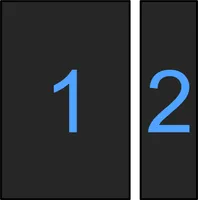
For example, the characters , , , have this shape.
난 shape
The second shape is like the 나 shape, but occurs when we have a (single letter) final consonant. The final consonant goes under the other letters.
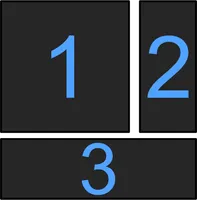
This shape is seen in the characters , , and , for example.
노 shape
With wide vowels such as ㅗ (o), ㅜ (u), ㅡ (eu) we stack the letter vertically instead of horizontally.
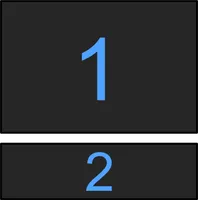
For example, this shape occurs in the characters , , and .
논 shape
We also have a shape similar to the 노 shape, but with a (single letter) final consonant. The final consonant goes under the other letters.
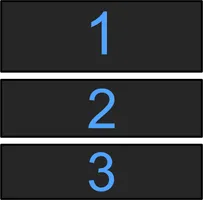
For example, this shape occurs with the characters , , , and .
낡 and 놁 shapes
The final shapes occur when we have double consonants.
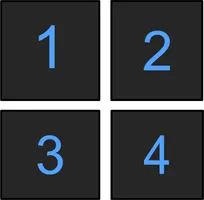
If we have a tall vowel, we get the 낡 shape shown above. Examples are: (nak), (al), and (gak).
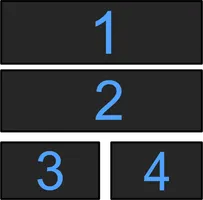
If we have a wide vowel, we get the 놁 shape shown above. Examples are: (heuk) and (geuk).
More on two-letter final consonants
There are many theoretically possible combinations of two final consonants letters which could form a (double) final consonant. For example one could imagine a final consonant formed from the consonants ㄱ and ㄴ. In reality, no such final consonant exists. There are only 11 two-letter final consonants which occur in modern Korean. You don’t need to memorize these, but for your interest the possible double final consonants are: ㄳ, ㄵ, ㄶ, ㄺ, ㄻ, ㄼ, ㄽ, ㄾ, ㄿ, ㅀ, ㅄ.
Shapes Quiz
Complete this quiz to make sure you have a solid understanding of the different shapes that hangul characters can form.
Hangul shapes quiz
A few pronunciation tips
I gave you rough equivalents in English of each Hangul letter, but these are not perfect. The most important part of having good pronunciation is using your ears and not relying on the English equivalents. Some tips are still useful when you’re still starting, so I will go over some of the most confusing points of Korean pronunciation for English speakers.
At this stage in your Korean learning journey, you shouldn’t worry about trying to have perfect pronunciation, because you won’t. Even if you just notice that the sounds in Korean are different from the so-called “equivalents” that we have in English, you’re doing a good job of listening.
The letter ㄹ
You can find many explanations in textbooks or online that the letter ㄹ makes either an r sound if it’s an initial consonant, or as an l sound if it’s a final consonant. So is pronounced as mal and is pronounced as ra.
This is roughly true. However, in reality the ㄹ (l/r) sound is a completely different sound from what we have in English. It is pronounced by tapping your tongue behind your teeth. The slower the tap is, the more it will sound like an l, and the faster the tap, the more it will sound like an r. As a final consonant there is no tap at all, so it sounds most like an l. As you may have heard with , even though ㄹ is an initial consonant, it may still sound like an l depending on the speaker and the speed of speech.
One caveat to this is that there are rules dictating when final consonants are pronounced as initial consonants. For example, in 말이 (mal-i), despite ㄹ being a final consonant the word is actually pronounced as (ma-ri) with an initial consonant ㄹ. We will discuss these rules in detail in a later lesson.
The letter ㅅ
The letter ㅅ makes an s sound. However, as we will learn in another lesson, there is another letter which also makes an s sound: The letter ㅆ. The difference between the two letters is in the strength of the air that comes out of your mouth.
In this clip, the speaker says 사 싸 사 싸. To your ear, they likely sound very similar. A useful tip is that you should pronounce ㅅ quieter than you would pronounce an s sound in english.
Also, when followed by certain vowels, the ㅅ letter sounds like sh to us English speakers.
- (si) sounds like shi
- (sya) sounds like sha
- (syo) sounds like sho
- (syeo) sounds like sheo
The letter ㅇ
The letter ㅇ makes no sound as an initial consonant, so ㅇ+ㅏ = simply makes an a sound, ㅇ+ㅜ = simply makes a u sound.
If ㅇ also made no sound as a final consonant, it would be completely pointless. Thus as a final consonant ㅇ instead makes a ng sound. For example,
- is pronounced as bang
- is pronounced as gang
Other letters
The other letters are also slightly different from their English “equivalents”, in subtle ways. Rather than trying to explain these differences which you may not even be able to hear, the best way to pick up on these differences is to consume to a lot of Korean content and listen closely to the pronunciation. After some time, you will naturally start to pick up on the subtle differences.
ㄹ, ㅅ, ㅇ quiz
Hangul ㄹ, ㅅ, ㅇ quiz
Aspiration - the difference between g and k
Consider these Hangul letter pairs:
- ㄱ — ㅋ (g and k)
- ㅂ — ㅍ (b and p)
- ㅈ — ㅊ (j and ch)
- ㄷ — ㅌ (d and t)
They are very similar. They only differ in one aspect — their aspiration.
To see this, try pronouncing ga then ka in English while paying close attention to how exactly you’re making the sound, you’ll notice that in each case your mouth and tongue do exactly the same thing. One difference is the amount of air that comes out of your mouth. That’s aspiration.
You can do the same exercise with ba and pa, ja and cha, and da and ta. To better feel the difference, try putting your hand in front of your mouth as you pronounce each pair. With the aspirated sounds ka, pa, cha, ta (and , , , ) you should feel a puff of air on your hand.
In our Hangul chart we said that ㄱ is equivalent to the letter g. However, if you listened to the audio files, you may have noticed that it sometimes sounds more like a k. There are several reasons for this. One reason is that the amount of aspiration is somewhere between the English g and k sounds. The other reason is…
Voicing
Another reason that ㄱ sounds like k to English ears is that the Korean ㄱ is less voiced than the English g, which means the vocal folds in the throat vibrate less. Usually in English we use the difference in vocal fold vibration to distinguish between g and k. Without it, it can be hard to distinguish the pairs of sounds.
In order to distinguish between these pairs you should therefore try to focus on listening for the high pitched sound of a puff of air, rather than focusing on the lower pitched sound caused by vocal fold vibration.
Aspiration in action
Compare for yourself and see if you can hear the difference in aspiration:
- vs
- vs
- vs
- vs
Aspiration quiz
Aspiration quiz
Letters sometimes appear different?
You may have noticed that the ㄴ (n) sound appears slightly different depending which part of the character it appears in. For instance between the two characters and , ㄴ is taller in 나 as opposed to 한. This is done so that the characters are all roughly the same box shape. For a more extreme example, look at the final consonant ㅎ in .
Initial Consonant (초성)
ㅈVowel (중성)
ㅗFinal Consonant (종성)
ㅎThe ㅎ in 좋 appears rather squished. You will quickly get used to reading the characters even with these slight differences.
If you do come across a character that you’re having trouble reading, first think about what shape the character is, then try to pick out the individual consonants and vowels. Remember that there will only ever be 2 to 4 letters in the character.
Tricky characters quiz
To practice reading these trickier characters, try out this quiz.
Tricky Hangul characters quiz
A note about romanization
The process of writing Hangul characters in the latin alphabet is called romanization. I have been writing the romanization of the Hangul characters in parentheses throughout this article. Your final quiz will also ask you to determine the romanization of various Hangul characters. For example:
- The romanization of is han
- The romanization of is gang
- The romanization of is mot
Although I am teaching you the romanization, I strongly recommend you memorize Hangul as quickly as possible and do not continue to rely on romanizations. While it is very useful for first learning Hangul, the romanizations are not entirely accurate representations of the sounds of the Korean language. For example, the character is romanized as neo. Go ahead and listen to the pronunciation and determine for yourself if you think it’s a good romanization of that sound.
Initial Consonant (초성)
ㄴVowel (중성)
ㅓFinal Consonant (종성)
N/ABeyond the inaccuracy of the romanization, in order to consume Korean TV, books, and other media it is crucial that you are able to read Hangul rather than rely on romanization.
In future lessons, I will gradually use less and less romanization. Compared to the hundreds (and likely thousands) of hours it takes to learn Korean fluently, learning to read Hangul without romanization will only take you a tiny fraction of that time and it’s well worth the effort.
Final quiz
Finally, before moving on to learn your first Korean words, let’s make sure you can now read some simple Hangul characters! I suggest trying the quiz several times until you get a good score. Each time you attempt the quiz there will be new questions.
Basic Hangul Final Quiz
Practice your knowledge of the basic hangul characters we've learned in this lesson